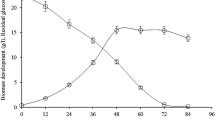Abstract
In the present investigation, the previous ultraviolet irradiated mutant strain of Aspergillus oryzae UV-7 was further improved in terms of 3,4 dihydroxy phenyl L-alanine (L-DOPA) activity after chemical mutagenesis through 1-methyl 3-nitro 1-nitroso guanidine (MNNG = 250–1500 μg/ml) treatment (0–30 min). Among several mutant variants, the one that produced a larger amount of L-DOPA from L-tyrosine was designated to as ME2 and it was made 2-deoxy-D-glucose-resistant by growing it at various concentrations of 2 dg (0.01–0.025 %, w/v) in Vogel’s agar medium. Relatively better production of L-DOPA (> 0.60 mg/ml) was obtained when 2.0% (w/v) glucose was used as a carbon source in the mycelium production medium and the tyrosinase activity increased constitutively (1.08 mg/ml), which resulted in a greater production of L-DOPA. At optimum pH0 (pH 6.0) and reaction time (60 min), more than 65% sugar was utilized for cell mass formation. The maximum conversion of L-tyrosine to L-DOPA (0.428 mg/ml) was achieved 60 min after the biochemical reaction. Mould mycelium was used for microbiological conversion of L-tyrosine to L-DOPA because tyrosinases, β-carboxylases, and tyrosine hydroxylases are intracellular enzymes. The effect of illite (1.0 × 106–6.0 × 106 M) on biochemical conversion of L-tyrosine to L-DOPA by Aspergillus oryzae ME2 was also carried out. Best results of L-DOPA biosynthesis were observed when the concentration of illite was 3.5 × 10−6 M (1.686 mg/ml L-DOPA produced with 1.525 mg/ml consumption of L-tyrosine). It was noted that the addition of illite not only increased enzyme activity but also enhanced the permeability of cell membrane to facilitate the secretion of enzymes into the reaction broth. The comparison of kinetic parameters showed the ability of mutant to yield L-DOPA (i.e., Yp/x 7.360 ± 0.04 mg/mg). When the culture grown on various illite concentrations was monitored for Qp, Qs, and qp, there was significant enhancement (p < 0.025) in these variables over the control, which indicate that the study can be commercially applicable on stirred and magnetic rotary drums. Overall, there was up to 3-fold (Qp = 0.290 mg/L-DOPA produced/ml/h) enhancement in the product formation rate, which is highly encouraging (HS, LSD 0.456).






Similar content being viewed by others
Literature Cited
Archer DB (2001) Genetic engineering: Yeasts and filamentous fungi. Basic Biotechnology, 2nd ed. Cambridge University Press, Cambridge, UK. p 95–126
Fling G (1998) Radiation induced effects on L-3,4 dihydroxy phenyl alanine by Aspergillus oryzae. J Anal Chem 67:185–187
James P, Fling G (2001) Tyrosinase activity of different fungal strains. Biochem Biophys 112:98–103
Toyama H, Yamada M, Shinagawa E, Matsushita K (2003) New developments in oxidative fermentation. Appl Microbiol Biotechnol 60:643–653
Sehgal D, Gopinathan KP (2004) Molecular biology and biotechnological applications for large-scale synthesis of recombinant proteins. Curr Sci 83:455–465
Singh H (1999) Mechanism of oxidation of L-tyrosine by fungal tyrosinases. J Chem 172:83
Rosazza KC, Paul GM, Wolf S (1995) The microbial sources of tyrosinases. Biotechnol Lett 16:210–215
Raju BG, Rao GH, Ayyanna C (1993) Bioconversion of tyrosine to melanin using mycelia of Aspergillus spp, CBS Publishers, Visakhapatnam India, p 37–58
Haq I, Ali S, Manzoor S, Qadeer MA (2000) Optimization of cultural conditions for the production of L-DOPA from L-tyrosine by Aspergillus oryzae. Pak J Bot 32:255–258
Rarveen JK, Michael LC (1992) Clinical medicines, ELBS 2nd ed. CBS Publishers, London, UK. p 141–210
Pontecarvo J, Roper JA, Hemmous LM, Buftan W (1969) Basic techniques of UV-irradiation and chemical treatments. Adv Genet 5:141–183
Haneda K, Watanabe S, Takeda P (1973) L-DOPA by microorganisms. J Ferment Technol 51:398–406
Arnow LE (1937) Colorimetric determination of the components of 3,4-dihydroxy phenyl L-alanine in tyrosine mixtures. J Biochem 88:531
Pirt SJ (1975) Principles of cell cultivation. 2nd ed. Blackwell Scientific Corporation, London, UK. p 116
Snedecor G, Cochran WG (1980) Statistical methods, 7th ed. Iowa State University. pp 80–86
Sih CJ, Foss P, Rosazza J, Lembagar M (1969) Biosynthesis of L-3,4-dihydroxy phenylalanine from mealworms. J Ann Chem Soc 91:62–64
Andrews G (2002) Estimating cell and product yields. Biotechnol Bioengin 33:256–265
Bubbico R, DiMichele A, Verdone N (2001) Selectivity in metabolic products of Yarrowia lipolytica. Enzyme Microbial Technol 28:189–195
Haq I, Iqbal F, Qadeer MA (1998) Production of L-DOPA from L-tyrosine by Aspergillus oryzae. Biologia 44:31–39
Kumagai LS, Fling M, Sarin AN (1969) Mushroom tyrosinases. J Biol Chem 68:178–185
Nofre C, Cier A, Saucet CM, Parent J (1960) Action of free hydroxyl radicals on amino acids. Med Lyon J 251:81–82
Paul SP (1974) Amino acids and 3,4 dihydroxy phenyl L-alanine idiopathic actions. Sci Med 43:73–76
Roy D, Das RM (1978) Mutation of microorganisms to complete change in physiological sequences. Amniotic Tech Chem 159:172–183
Author information
Authors and Affiliations
Corresponding author
Rights and permissions
About this article
Cite this article
Sikander, A., Ikram-ul-Haq Innovative Effect of Illite on Improved Microbiological Conversion of L-Tyrosine to 3,4 Dihydroxy Phenyl L-Alanine (L-DOPA) by Aspergillus oryzae ME2 Under Acidic Reaction Conditions. Curr Microbiol 53, 351–357 (2006). https://doi.org/10.1007/s00284-005-0220-x
Received:
Accepted:
Published:
Issue Date:
DOI: https://doi.org/10.1007/s00284-005-0220-x




